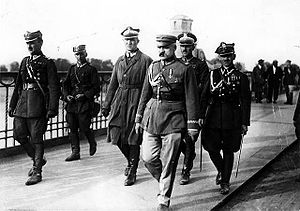- May Coup (Poland)
-
For other coups d'état in May, see May Coup.
The May Coup d'Etat, Przewrót majowy (1926) 
Piłsudski and other coup leaders on Poniatowski Bridge in Warsaw.Date 12 – 14 May 1926 Location Warsaw, Poland Result Sanacja victory Belligerents Sanacja-loyal army Government-loyal army Commanders and leaders Marshal Józef Piłsudski President Stanisław Wojciechowski,
Prime Minister Wincenty WitosStrength 12,000 6,000-8,000 Casualties and losses Military killed: 215
Civilians killed: 164
Military and civilian wounded: 920
Total: 1,299The May Coup d'État (Polish: Przewrót majowy or zamach majowy) was a coup d'état successfully carried out in Poland by Marshal Józef Piłsudski between 12 and 14 May 1926. The coup overthrew the government of President Stanisław Wojciechowski and Prime Minister Wincenty Witos. A new government was installed, headed by Lwów Polytechnic Professor Kazimierz Bartel, and supported by the Sanation political movement.
Initially Piłsudski was offered the presidency, but he declined in favor of Ignacy Mościcki. Piłsudski, however, remained the most influential politician in Poland, and became its de facto dictator until his death in 1935.
Contents
Buildup
In November 1925 the government of Prime Minister Władysław Grabski was replaced by the government of Prime Minister Aleksander Skrzyński, which had received support from the National Democracy and the Polish Socialist Party (PPS). General Lucjan Żeligowski became the new government's minister of military affairs. However, after the PPS withdrew its support, this government also fell and was replaced by that of Prime Minister Wincenty Witos, formed by PSL Piast and Chrześcijański Związek Jedności Narodowej (Chjeno-Piast). However, the new government had even less popular support than the previous ones, and pronouncements from Józef Piłsudski, who viewed the constant power shifts in the Sejm (Polish parliament) as chaotic and damaging, set the stage for a coup d'état.
Apart from domestic turmoil, Polish politics had been shaken by a trade war with Germany, begun in June 1925, and by the signing of the Treaty of Locarno on October 16. Under the terms of the treaty, the World War I western European Allied powers and the new states of Central and Eastern Europe sought to secure a postwar territorial settlement in return for normalized relations with defeated Germany.
Coup d'état
On 10 May 1926 a Chjeno-Piast government was formed, and that same day Józef Piłsudski, in an interview with Kurier Poranny (the Morning Courier), said that he was "ready to fight the evil" of Sejmocracy and promised a "sanation" (restoration to health) of political life. The newspaper edition was confiscated by the authorities.
The night of 11 May to 12 May a state of alert was declared in the Warsaw military garrison, and some units marched to Rembertów, where they pledged their support to Piłsudski. On 12 May they marched on Warsaw and captured bridges over the Wisła River. Meanwhile Wincenty Witos' government declared a state of emergency.
 Piłsudski (center) on Poniatowski Bridge, Warsaw, 12 May 1926, during the May Coup d' État. At right is Gen. Gustaw Orlicz-Dreszer.
Piłsudski (center) on Poniatowski Bridge, Warsaw, 12 May 1926, during the May Coup d' État. At right is Gen. Gustaw Orlicz-Dreszer.
At about 17:00 hours, Marshal Piłsudski met President Stanisław Wojciechowski on the Poniatowski Bridge. Piłsudski demanded the resignation of Witos' cabinet, while the President demanded Piłsudski's capitulation. With no result in this round of negotiations, fighting erupted about 19:00 hours.
Next day a new round of negotiations was begun, mediated by Archbishop Aleksander Kakowski and Marshall of the Sejm Maciej Rataj. These negotiations, however, brought no change to the stalemate. On 14 May the Polish Socialist Party declared its support for the rebels and called for a general strike, supported by the Railwaymen's Union (Związek Zawodowy Kolejarzy). The strike by socialist railwaymen paralyzed communications and prevented pro-government military reinforcements from reaching Warsaw.[1]
Eventually, to prevent the Warsaw fighting from turning into a country-wide civil war, Wojciechowski and Witos resigned their offices.
During these events, 215 soldiers and 164 civilians were killed, and some 900 people were wounded.
A new government was formed under Prime Minister Kazimierz Bartel, with Piłsudski as minister of military affairs. On 31 May the National Assembly (Zgromadzenie Narodowe) nominated Piłsudski to be president, but he declined to accept. Eventually Ignacy Mościcki became the new president; Piłsudski, however, wielded much greater de facto power than his military ministry nominally gave him.
Consequences
Piłsudski initiated Sanation government (1926-39) — conducted at times by authoritarian means — directed at restoring moral "health" to public life. Although until his death in 1935 Piłsudski played a preponderant role in Poland's government, his formal offices — apart from two stints as prime minister in 1926-28 and 1930 — were for the most part limited to those of minister of defense and inspector-general of the armed forces.
The adoption of a new Polish constitution in April 1935 (the April Constitution), tailored by Piłsudski's supporters to his specifications — providing for a strong presidency — came too late for Piłsudski to seek that office. But the April Constitution would serve Poland until the outbreak of World War II and would carry its Government in Exile through the war and beyond.
Notes
- ^ Davies, op cit, Google Books, p.422
References
- Joseph Rothschild, Pilsudski's Coup D'État, Columbia University Press, 1967, ISBN 0-231-02984-5.
External links
Categories:- 1926 in Poland
- Conflicts in 1926
- Military coups in Poland
- History of Poland (1918–1939)
Wikimedia Foundation. 2010.
